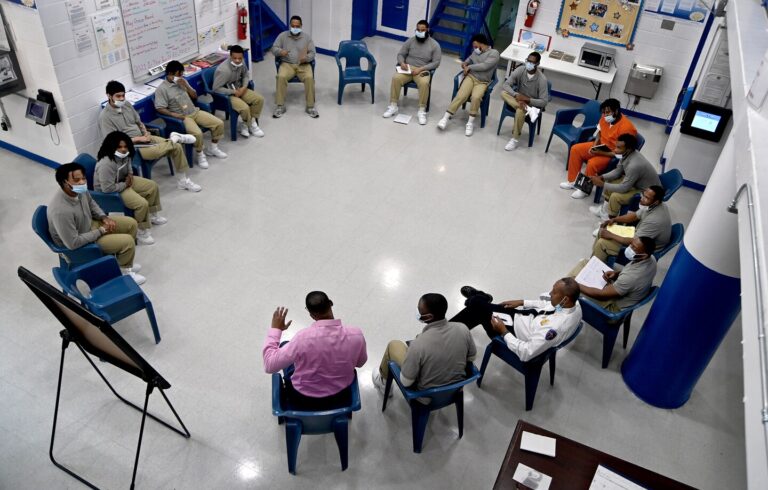
“The goal of this to think down to the nitty-gritty of what this new facility can look like, feel like, smell like,” said Angel Gregorio, a small-business owner who has had multiple family members incarcerated and volunteered to moderate the discussion. “We are designing a jail, and we need everybody here to put on their designer hat.”
In March, D.C. Mayor Muriel E. Bowser (D) allocated more than $250 million over six years in the city’s capital budget proposal to design and build an annex to the Correctional Treatment Facility at the D.C. jail, where women and some men in minimum security are detained. Bowser’s plan would pave the way to permanently shutter the adjacent Central Detention Facility, which was built in 1976.
The discussion comes after the District has struggled to address concerns over conditions at the jail. In November, the U.S. Marshals Service told the Department of Corrections that some people detained facing federal charges would be transferred to a prison in Pennsylvania after an inspection found the punitive denial of food and water, and unsanitary living conditions at the jail.
This week’s forum was the fourth in a series designed to solicit community input that will be summarized and sent in a letter to Bowser, the D.C. Council and city corrections officials as city leaders prepare a design phase for the proposed facility, said Casey Anderson, policy and communications manager for the Council for Court Excellence. The nonprofit, nonpartisan organization conducts research and seeks policy solutions for the criminal justice system, according the group’s website.
The group plans to host two more forums next week, Anderson said.
Some residents and activists suggested creating painting programs to bring bright, vibrant colors to the jail walls along with encouraging messages to help improve incarcerated peoples’ attitudes. Other ideas included creating a landscaped, college campus environment that remained clean and sanitized. Some asked for windows that could even be opened to let in fresh air.
Leonard Smith, 36, who was locked up on a first-degree murder charge that he said was finally dropped just weeks ago, argued that a clean, more respectful facility was necessary. But he still didn’t want more comforts and amenities to distract men and women from learning lessons to keep them from losing their freedom in the first place.
“I don’t want to go in there and lay back and be comfortable,” Smith told the group.
In an interview, Smith explained that he had been in and out of jails since he was 18, and he met many people who never learned how to function on the outside. They kept getting arrested to avoid homelessness in the winter or trouble in neighborhoods, he said.
“I don’t want to go into a facility and I got a 60-inch flat screen TV. I don’t want people to go in there and think that it’s a playground or summer camp,” Smith said in a phone interview. “Don’t go in and come out the same way; I want people to change. I want them to seek change.”
Neighbors for Justice’s Anthony Petty, who returned to the District nearly two years ago after 30 years of incarceration, countered that improving programming and overall conditions would not stop the chance for people to rehabilitate.
Petty first entered prison in Lorton as a 16-year-old and later traveled to prison facilities in Ohio, Pennsylvania, Tennessee and several in Virginia, he said in an interview, places where violence and negativity fester far deeper than most jail settings.
“When you go to places like that, you adapt to your environment,” Petty told the group.
The 48-year-old now works as a community activist geared toward stopping violence and connecting with people who are still “behind the wall,” he said in an interview.
“We have to think outside of the box with prisons,” Petty said. “I want to be in a place where I can learn and do something positive. You don’t have to be inhumane for a person to understand that they are incarcerated.”
The group heard proposals to provide new training for corrections officers that would offer cultural competency, specifically targeting the unique experiences of District residents, and how to better engage people under stress.
Another person urged hiring officers with roles that better foster rehabilitative efforts rather than serving as minders focused solely on maintaining safety and security.
Brittany Vazquez, 29, a forensic social worker who previously worked as a D.C. jail case manager and at Rikers Island in New York City, said the city needed to improve reentry services, including providing better access to medications and mental services.
Other ideas included more universal access to counseling services to all jailed men and women, rather than just for those diagnosed with mental health issues.
Perhaps the most popular idea presented, centered on creating better access for incarcerated parents to interact with their children and be involved in their schooling and development.
“This is a great idea! When I worked in NYC jails, there was a program for the incarcerated people to virtually read books to their children,” Vazquez wrote in a chat to meeting attendees. “Keeping families connected is crucial for individuals to successfully transition back into the community.”